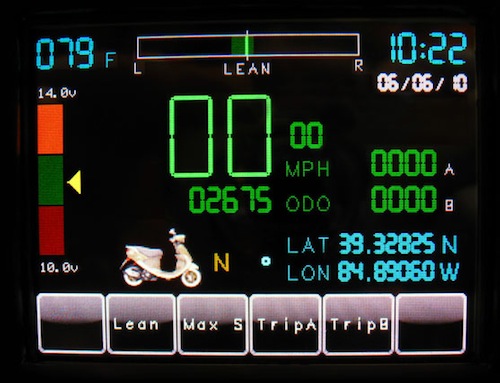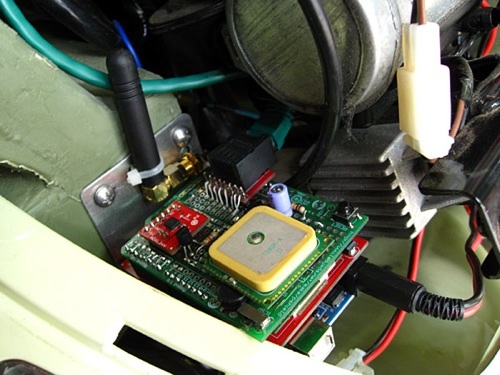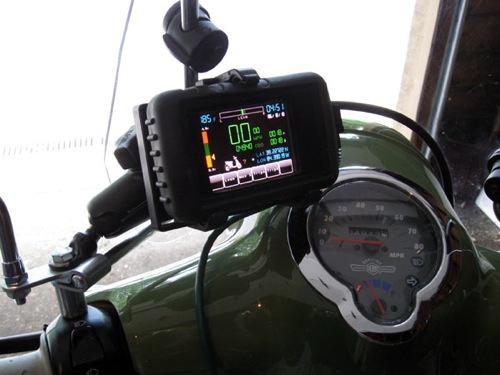It seems as if the best projects start out as a seedling of an idea and then grow into something much more. This project is one of those - the Scooterputer.

This project from SparkFun customer Kurt Schulz began when Kurt wanted to add a voltage meter to his scooter to monitor the battery. He often zips around town on his bike and would rather have an accurate reading of his battery level than simply guessing when his starter wouldn't crank - makes sense, I'd say. As is the case with most electronics tinkerers, Kurt didn't stop there. He added a temperature sensor....and an accelerometer...and GPS...and a real-time clock module...and, oh yeah, a cell phone module - all harnessed through an Arduino. What he ended up with was something like this:

This thing is awesome. Not only does it tell Kurt how much juice his battery has, but it also does the following:
- Time and date
- Temperature
- Lean gauge with resettable max L-R indicators
- Current speed
- Resettable max speed indicator
- Odometer
- 2 resettable trip meters
- Latitude and longitude readouts
- Compass heading readout
- GSM/GPRS quad-band cellular module

If someone attempts to "borrow" his scooter without permission, he'll get a text telling him where it is, how fast it's going, and in what direction. Amazing. He can also send a text from another phone and the Arduino will reply with information like position, speed, heading, time and date. This is a great combination of different technologies all wrapped up into an incredibly useful project.

Kurt didn't stop there, but added a very slick enclosure and did an outstanding job of mounting up his device. Amazing work! Keep an eye on Kurt's blog to check out his future projects!






mdot: As I was reading the post, I just keep asking myself, "what's he using the accelerometer for?"
I'm still kinda wondering the same thing. On a motorcycle/scooter, you lean in a corner such that a net force vector from your center of mass always points at the tire contact patch (otherwise you'd fall over). Depending on how fast you corner, the magnitude of the force might change measurably, but the direction would always be "straight down" from the perspective of an accelerometer mounted on the bike.
Is there another way to measure lean angle that isn't confused by dynamic cornering forces?
Nice Project! The functions can also be done using an iPhone app?
I need to know which product is the best from the ones listed on the site?
As you can tell from the comments, this post is over 9 years old. I am pretty sure we no longer carry most of the products used in this tutorial.
If you are looking for technical assistance with some product recommendations, please use the link in the banner above, to get started with posting a topic in our forums. Our technical support team will do their best to assist you. Just as a note, we don't provide step-by-step instructions for this project (we will offer support getting started using individual products, but it will be up to the user to take various components and bring them together to build this project).
This should be sold. When will it be available on SparkFun?
Did anyone else take the "Lean" measurement to mean fuel / oxygen mixture?? L for lean and R for rich??
Guilty.
As I was reading the post, I just keep asking myself, "what's he using the accelerometer for?"
Pretty sure thats for the lean of the scooter.
Mmmmmmm I'd like it better if he had a fuse on that power supply line.
Other than that its fantastic. Good bit of kit showing just what the Arduino is capable of.
This is brilliant. I had an identical idea for my motorcycle.
Which I don't have yet.
And probably won't for several years.
sadface.
Pretty cool! with flow sensor he could determine his current MPG and estimate how many miles until the tank needs refilled.
This is a product that is worthy of being sold as an after-market add-on. What a wonderful piece of work!
Tell me, are the speed and odometer readings taken from the scooter's internal systems, or are they derived from the GPS?
I applaud Kurt's inspirational work on this. I find the layout and design of the display screen especially well thought-out and easy to read.
He's using GPS.
Pretty cool, I wonder where that enclosure is from?
If you go to his page:
http://www.janspace.com/b2evolution/arduino.php/2010/06/26/scooterputer
And scroll down a bit, you can see where he got the case and how he modified it to work.
Note: It's not an electric scooter. The battery gauge is for the battery for his electric starter.
D'oh! You are correct - I'll edit that.
Does anybody know what display he used? It looks as if it would be touchscreen, given the Max S and Trip A Trip B "buttons" on the bottom of the display.I would image it is also quite hard to see in direct sunlight...
It would be very cool to add an LDR somewhere and add an auto-brightness feature, just like the iPhone.
He's using Liquidware's TouchShield Slide OLED display.
Cool! Thanks!
Really nice project and very useful ! good job !
Wow, and all powered by (I assume) an ATmega328. Truely amazing. i guess it goes to show that you don't need to replace the engine, put on new brakes, and replace the tires to end up with a pimp-my-ride scooter!
I would like to adapt this to a power wheelchair. This is exactly what I have been wanting to add to my chair.
That is one tricked out scooter!
Wow,Bravo, Encore, I hope any of my projects come out a fraction as cool as this.